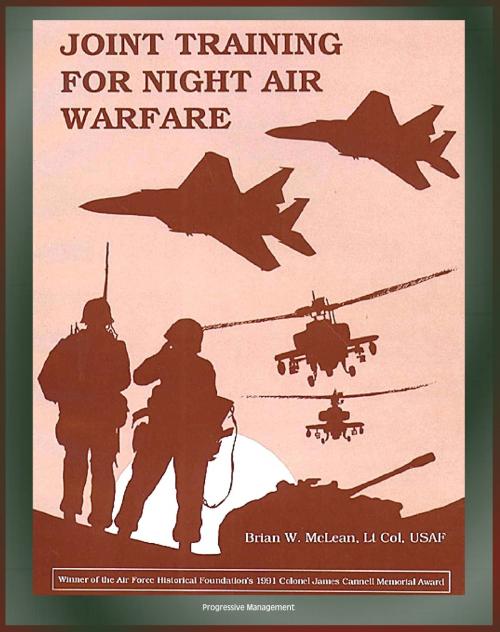Joint Training for Night Air Warfare: Red Flag, Cope Thunder, and the National Training Center, Close Air Support, Counterair
Nonfiction, History, Military, Aviation, United States| Author: | Progressive Management | ISBN: | 9781476027180 |
| Publisher: | Progressive Management | Publication: | June 7, 2012 |
| Imprint: | Smashwords Edition | Language: | English |
| Author: | Progressive Management |
| ISBN: | 9781476027180 |
| Publisher: | Progressive Management |
| Publication: | June 7, 2012 |
| Imprint: | Smashwords Edition |
| Language: | English |
The reality of today's world is that although the threat of World War III may be greatly reduced, the possibility of wars involving American troops remains high. These wars probably will be conducted by large and complex joint staffs and likely will be characterized by intense activity carried out regardless of weather, time of day, or seasons of the year. Our most recent experiences in Panama, Grenada, Libya, and the Persian Gulf have proven that modern war requires joint air, land, and naval forces fighting both day and night. Are we preparing to do this? Are we training for air operations using all forces at our disposal in a war that may begin in the middle of the night?
The author's contention is that training for night air operations, particularly with our sister services, is in its infancy. Using his personal experience he sets out to recommend better uses of the training facilities of all the services to improve the situation. After examining the history of joint operations and night air operations, presenting a hypothetical joint night scenario to show the tremendous challenges of such operations, and describing the current status of joint night training programs, the author recommends a phased building-block approach that should increase the Air Force's capability to perform both single-service and joint operations any time of the day or night. This will ensure that we train as we plan to fight in future air operations.
Chapter 1 addresses the history and background of both joint air operations and night warfare to explain how we reached the point where we are today. Chapter 2 addresses the current status of our night air warfare equipment and our system for planning and conducting joint warfare. The author uses a hypothetical air operation against North Korean forces to illustrate some of this capability. Chapter 3 examines the various large-scale training programs and exercises used to practice for night warfare, particularly to determine where weaknesses or limitations might exist. Chapter 4 discusses possible ways of making better use of available equipment and resources for more realistic training in joint night warfare.
Contents: 1 HISTORY AND BACKGROUND * Joint Operations * Night Operations * Summary * Notes * 2 DOING IT IN THE DARK—THE CHALLENGE * Operation Tae Kwon Do * Mission Planning * Offensive Counterair * Defensive Counterair * On-Call Close Air Support * Mission Execution * Offensive Counterair * Defensive Counterair * On-Call Close Air Support * Mission Feasibility * Summary * Notes * PHOTO SECTION * 3 CURRENT TRAINING PROGRAMS * Requirements for Realistic Training * Red Flag * Naval Strike Warfare Center * National Training Center * Twentynine Palms * Cope Thunder * Team Spirit * Summary * Notes * 4 CONCLUSIONS AND RECOMMENDATIONS * Expanding Air Force Night Capability * Recommendation 1: Implement Red Flag 2000 Proposal * Recommendation 2: Initiate Annual Night Cope Thunder * Expanding Joint Capability * Recommendation 3: Develop More Extensive Joint Force Tactics * Recommendation 4: Expand Formal Joint Training Programs * Recommendation 5: Begin Mission Commanders' School at Red Flag * Recommendation 6: Initiate Annual Unified Command Red Flag * Developing Joint Night Capability * Recommendation 7: Expand Joint Night Training at Each Center * Recommendation 8: Increase Joint Night Operations at Team Spirit * Recommendation 9: Develop an Annual Unified Command Exercise * Summary * Notes
The reality of today's world is that although the threat of World War III may be greatly reduced, the possibility of wars involving American troops remains high. These wars probably will be conducted by large and complex joint staffs and likely will be characterized by intense activity carried out regardless of weather, time of day, or seasons of the year. Our most recent experiences in Panama, Grenada, Libya, and the Persian Gulf have proven that modern war requires joint air, land, and naval forces fighting both day and night. Are we preparing to do this? Are we training for air operations using all forces at our disposal in a war that may begin in the middle of the night?
The author's contention is that training for night air operations, particularly with our sister services, is in its infancy. Using his personal experience he sets out to recommend better uses of the training facilities of all the services to improve the situation. After examining the history of joint operations and night air operations, presenting a hypothetical joint night scenario to show the tremendous challenges of such operations, and describing the current status of joint night training programs, the author recommends a phased building-block approach that should increase the Air Force's capability to perform both single-service and joint operations any time of the day or night. This will ensure that we train as we plan to fight in future air operations.
Chapter 1 addresses the history and background of both joint air operations and night warfare to explain how we reached the point where we are today. Chapter 2 addresses the current status of our night air warfare equipment and our system for planning and conducting joint warfare. The author uses a hypothetical air operation against North Korean forces to illustrate some of this capability. Chapter 3 examines the various large-scale training programs and exercises used to practice for night warfare, particularly to determine where weaknesses or limitations might exist. Chapter 4 discusses possible ways of making better use of available equipment and resources for more realistic training in joint night warfare.
Contents: 1 HISTORY AND BACKGROUND * Joint Operations * Night Operations * Summary * Notes * 2 DOING IT IN THE DARK—THE CHALLENGE * Operation Tae Kwon Do * Mission Planning * Offensive Counterair * Defensive Counterair * On-Call Close Air Support * Mission Execution * Offensive Counterair * Defensive Counterair * On-Call Close Air Support * Mission Feasibility * Summary * Notes * PHOTO SECTION * 3 CURRENT TRAINING PROGRAMS * Requirements for Realistic Training * Red Flag * Naval Strike Warfare Center * National Training Center * Twentynine Palms * Cope Thunder * Team Spirit * Summary * Notes * 4 CONCLUSIONS AND RECOMMENDATIONS * Expanding Air Force Night Capability * Recommendation 1: Implement Red Flag 2000 Proposal * Recommendation 2: Initiate Annual Night Cope Thunder * Expanding Joint Capability * Recommendation 3: Develop More Extensive Joint Force Tactics * Recommendation 4: Expand Formal Joint Training Programs * Recommendation 5: Begin Mission Commanders' School at Red Flag * Recommendation 6: Initiate Annual Unified Command Red Flag * Developing Joint Night Capability * Recommendation 7: Expand Joint Night Training at Each Center * Recommendation 8: Increase Joint Night Operations at Team Spirit * Recommendation 9: Develop an Annual Unified Command Exercise * Summary * Notes















